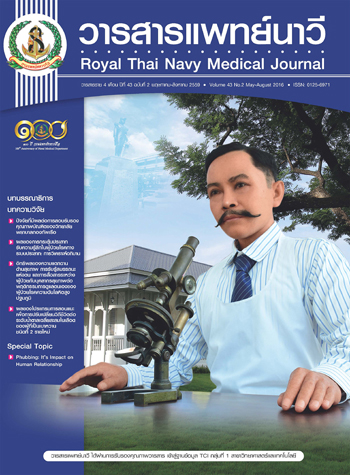ผลของการกระตุ้นประสาทรับความรู้สึกในผู้ป่วยโรคทางระบบประสาท : การวิเคราะห์อภิมาน
Main Article Content
Abstract
The purposes of this meta-analysis were to study methodological, substantive characteristics,
formats, health outcomes of sensory stimulation and to compare the effect of
sensory stimulation on health outcomes in common neurological patients. The samples were
ten studies from full text graduate thesis and other research in Thailand during 1996 to 2013.
Research instruments consisted of an executive summary form, and a research quality evaluation
form. The effect size for each study was calculated using method of Glass, McGaw,
and Smith10. This Meta-analysis yielded 18 effect sizes.
The results of this review revealed that: the majority of these studies were Master’s
thesis in the field of nursing science (90%). All studies were quasi-experimental research (100%).
Most of research studies’ qualities were level 2.c (80%). Also, most samples of these studies
were patients with severe traumatic brain injury (60%). The majority of sensory stimulation
formats were multimodal methods (90%). In addition, most of research outcomes of sensory
stimulation were level of consciousness and responses to arousals (21.8 %). Sensory stimulation
yielded the largest effect size (d=1.62) on responses to arousals outcome while the
smallest effect size (d=0.01) was length of stay. Five sensory modalities stimulation including
tactile, gustatory, olfactory, auditory, and visual, five times a day for 14 days, each lasting
15 to 30 minutes yielded the largest effect size (d=3.97).
Article Details

This work is licensed under a Creative Commons Attribution-NonCommercial-NoDerivatives 4.0 International License.
References
2. ธเนศ ชาญด้วยกิจ, วารินทร์ พัดทอง ,ศศิธร ศิริกุล. ผลการประเมินความเสี่ยงต่อการเสียชีวิตและผลลัพธ์ของผู้ป่วยบาดเจ็บสมอง ในหอผู้ป่วยหนักศัลยกรรมและอุบัติเหตุ. แพทย์สารทหารอากาศ 2552;5(3):28-34.
3. สุมาลี ซื่อธนากุล. Rehabilitation in traumatic brain injury. ใน ภัทราวุธ อินทรกำแหง, บรรณาธิการ. ตำราเวชศาสตร์ฟื้นฟู. กรุงเทพมหานคร: นำอักษรการพิมพ์; 2552. หน้า 130-8.
4. บรรพต สิทธินามสุวรรณ. Neurological recovery in surgical patients. [อินเทอร์เน็ต]. [เข้าถึงเมื่อ 22 มกราคม 2559]. แหล่งที่มา: https://www.elearning.ns.mahidol.ac.th/km/index.php/km-neurological-recovery-in-surgical-patients.
5. Chen H, Epstein J, Stern E. Neural plasticity after acquired brain injury: Evidence from function neuroimaging. PM R 2010; 2(12 Suppl 2): S306-12.
6. Das-Gupta R, Turner-Stokes L. Rehabilitation in practice traumatic brain injury. Disability and Rehabilitation 2002;24(13):654-65.
7. Lippert-Gruner M. Early rehabilitative of comatose patients after traumatic brain injury. NeurolNeurochir Pol 2010;44(5):475-80.
8. ศศิธร ศิริกุล. การสังเคราะห์วรรณกรรมเพื่อพัฒนาวิธีการกระตุ้นประสาทรับความรู้สึกในผู้ป่วยบาดเจ็บสมองที่ไม่รู้สึกตัว. [วิทยานิพนธ์ปริญญาพยาบาลศาสตรมหาบัณฑิต สาขาวิชาการพยาบาลผู้ใหญ่]. มหาวิทยาลัยมหิดล; 2550.
9. Gregson PRW, Meal AG, Avis M. Meta-analysis: the glass eye of evidence-based practice. Nursing Inq 2002;9(1):24-30.
10. Glass GV, McGaw B, Smith ML. Meta-analysis in social research. London: Sage Publications; 1981.
11. นงลักษณ์ วิรัชชัย. การวิเคราะห์อภิมาน. กรุงเทพมหานคร: นิชินแอดเวอร์ไทซิ่งกรุ๊ป; 2542.
12. The Joanna Briggs Institute. Joanna Briggs Institute Reviewer's Manual 2014. [Internet]. [cited 2015 December 4]. Available from: https://joannabriggs.org/assets/docs/sumari/ reviewersmanual-2014.pdf.
13. Cohen J. Statistical power analysis for the behavioral science. 2nd ed. Hillsdale, NJ: Lawrence Erlbaum Associates; 1988.
14. ธเนศ ชาญด้วยกิจ และศศิธร ศิริกุล. การฟื้นสภาพด้านการรู้คิดดีขึ้นในผู้ที่ได้รับบาดเจ็บสมองอย่างรุนแรงโดยใช้ Sensory Stimulation Program. เวชสารแพทย์ทหารบก 2551;61(2):93-9.
15. ภนิดา คำบัว. การพัฒนาแนวทางปฎิบัติทางการพยาบาลในการกระตุ้นประสาทรับสัมผัสในผู้ป่วยบาดเจ็บสมอง. [วิทยานิพนธ์ปริญญาพยาบาลศาสตรมหาบัณฑิต สาขาวิชาการพยาบาลผู้ใหญ่]. มหาวิทยาลัยมหิดล; 2549.
16. พรนิภา เอื้อเบญจพล. ผลของโปรแกรมการกระตุ้นประสาทรับความรู้สึกต่อการฟื้นสภาพในผู้ป่วยบาดเจ็บสมองที่ไม่รู้สึกตัว. [วิทยานิพนธ์ปริญญาพยาบาลศาสตรมหาบัณฑิต สาขาวิชาพยาบาลศาสตร์]. จุฬาลงกรณ์มหาวิทยาลัย; 2547.
17. วาสนา ธรรมสอน. ประสิทธิผลของการปฏิบัติการพยาบาลต่อผลลัพธ์ด้านสุขภาพของผู้ดูแลในครอบครัวของผู้ป่วยบาดเจ็บสมองและผู้ป่วยโรคหลอดเลือดสมอง: การวิเคราะห์อภิมาน. [วิทยานิพนธ์ปริญญาพยาบาลศาสตรมหาบัณฑิต สาขาวิชาพยาบาลศาสตร์]. จุฬาลงกรณ์มหาวิทยาลัย; 2550.
18. จันทพร ธีรทองดี. ผลของโปรแกรมการสนับสนุนความรู้ของผู้ดูแลต่อภาระการดูแลของผู้ดูแลและการฟื้นสภาพของผู้ป่วยบาดเจ็บที่สมอง. [วิทยานิพนธ์ปริญญาพยาบาลศาสตรมหาบัณฑิต สาขาวิชาพยาบาลศาสตร์]. จุฬาลงกรณ์มหาวิทยาลัย; 2548.
19. หนึ่งฤทัย บุตรมา. ผลของโปรแกรมการกระตุ้นประสาทรับความรู้สึกต่อการฟื้นสภาพของผู้ป่วยสูงอายุโรคหลอดเลือดสมองชนิดแตกในระยะเฉียบพลัน. [วิทยานิพนธ์ปริญญาพยาบาลศาสตรมหาบัณฑิต สาขาวิชาพยาบาลศาสตร์]. จุฬาลงกรณ์มหาวิทยาลัย; 2553.
20. เนาวรัตน์ ขันธิราช. ผลของโปรแกรมการกระตุ้นประสาทรับความรู้สึกต่อการฟื้นตัวในผู้ป่วยบาดเจ็บที่ศีรษะรุนแรง. [วิทยานิพนธ์ปริญญาพยาบาลศาสตรมหาบัณฑิต สาขาวิชาการพยาบาลผู้ใหญ่]. มหาวิทยาลัยขอนแก่น; 2548.
21. นภาพร มาศสุข. ประสิทธิผลของการมีส่วนร่วมของญาติผู้ดูแลในโปรแกรมกระตุ้นประสาทรับความรู้สึกต่อการฟื้นสภาพและภาวะแทรกซ้อนจากการนอนนานของผู้ป่วยบาดเจ็บที่สมองและความพึงพอใจของญาติผู้ดูแล. [วิทยานิพนธ์ปริญญาพยาบาลศาสตรมหาบัณฑิต สาขาวิชาการพยาบาลผู้ใหญ่]. มหาวิทยาลัยมหิดล; 2554.
22. พัชรินทร์ อ้วนไตร. ผลของการใช้เสียงพูดที่คุ้นเคยกระตุ้นประสาทรับความรู้สึกด้านการได้ยินต่อระดับความรู้สึกตัวและพฤติกรรมการตอบสนองการได้ยินในผู้ป่วยบาดเจ็บที่ศีรษะที่ไม่รู้สึกตัว. [วิทยานิพนธ์ปริญญาพยาบาลศาสตรมหาบัณฑิต สาขาวิชาการพยาบาลผู้ใหญ่]. มหาวิทยาลัยขอนแก่น; 2545.
23. รัมภ์รดา อินทร. ผลของการส่งเสริมให้ญาติมีส่วนร่วมในการดูแลผู้ป่วยบาดเจ็บศีรษะต่อการฟื้นฟูสภาพของผู้ป่วยและความพึงพอใจของญาติต่อการพยาบาลที่ได้รับ. [วิทยานิพนธ์ปริญญาพยาบาล ศาสตรมหาบัณฑิต สาขาวิชาการพยาบาลผู้ใหญ่]. มหาวิทยาลัยมหิดล; 2539.
24. ศิริพร ใจวัง. ผลของการกระตุ้นประสาทรับความรู้สึกต่อการตอบสนองเชิงพฤติกรรมการรับรู้ของของผู้บาดเจ็บที่สมอง. [วิทยานิพนธ์ปริญญาพยาบาลศาสตรมหาบัณฑิต สาขาวิชาการพยาบาลผู้ใหญ่]. มหาวิทยาลัยเชียงใหม่; 2549.
25. Burn N, Grove SK. The practice of nursing research: Appraisal, Synthesis, and Generation of evidence. 6th ed. St. Louis, Missouri: Saunders, 2009.
26. บุญใจ ศรีสถิตนรากูล. ระเบียบวิธีการวิจัยทางการพยาบาลศาสตร์. พิมพ์ครั้งที่ 5. กรุงเทพมหานคร: ยูแอนด์ไออินเตอร์ มีเดีย; 2553.
27. Polit DF, Hungler BP. Nursing research: Principle and method. 6th ed. Philadelphia: Lippincott; 1999.
28. ศุภกิจ สงวนดีกุล. ผลการรักษาบาดเจ็บศีรษะใน รพ. พระมงกุฎเกล้า. เวชสารแพทย์ทหารบก 2551;61(ฉบับพิเศษ 1); 52.
29. Mandeep, Kumar P. Effectiveness of early intervention of coma arousal therapy in traumatic head injury patients. International Journal of Head and Neck Surgery 2012;3(3):137-42.
30. Mandeep, Chitkara, N., Goel, S., Sood, S. Traumatic head injury: Early intervention by coma arousal therapy. Indian Journal of Neurotrauma 2013;10(1):13-8.
31. Oh H, Seo W. Sensory stimulation programme to improve recovery in comatose patients. Journal of Clinical Nursing 2003;12(3):394-404.
32. ราตรี สุดทรวง และวีระชัย สิงหนิยม. ประสาทสรีรวิทยา. พิมพ์ครั้งที่ 5. กรุงเทพมหานคร: โรงพิมพ์แห่งจุฬาลงกรณ์มหาวิทยาลัย; 2550.
33. Barbara K, Audrey B. Fundamentals of Nursing: concepts, process, and practice. 9th ed. Philadelphia: Wolters Klumer Health, Lippincott Williams, and Wilkins; 2012.
34. Chitkara N, Goel S, Sood S. Traumatic head injury: Early intervention by coma arousal therapy. Indian Journal of Neurotrauma 2013;10(1):13-8.


